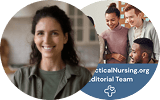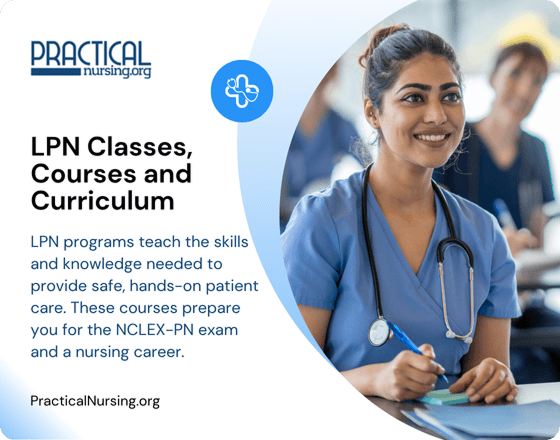LPN Classes, Courses, and Curriculum
LPN classes provide the foundation for a successful career in practical nursing. These courses combine classroom instruction with hands-on clinical training to equip students with the knowledge, skills, and confidence to care for patients across all stages of life. Each class is designed to prepare aspiring LPNs for real-world nursing responsibilities and licensure success.

Written by Jane Dewy and Edited by The PracticalNursing.org Editorial Team.

Licensed Practical Nurse (LPN) programs provide students with the knowledge, technical skills, and clinical training necessary to deliver safe, effective nursing care in a variety of healthcare settings. These programs typically take 12 to 18 months to complete and are structured to prepare students for the NCLEX-PN licensure exam. Coursework includes instruction in anatomy and physiology, pharmacology, medical-surgical nursing, maternal and pediatric care, mental health, and patient communication. Most programs are offered through community colleges, vocational schools, and some hospitals.
Introduction to Practical Nursing and the Healthcare Team
This course introduces students to the nursing profession, the history of healthcare, and the role of the LPN in today’s interdisciplinary care environment.
Topics include:
- History and evolution of nursing, including key figures like Florence Nightingale
- Scope of practice for LPNs and delegation protocols
- Overview of healthcare systems and patient care settings
- The nursing process: Assessment, diagnosis, planning, implementation, evaluation
- Developing therapeutic communication and professional boundaries
- Collaborating with RNs, physicians, therapists, and other care team members
Legal, Ethical, and Cultural Considerations in Nursing
This course prepares students to understand their legal responsibilities and uphold ethical standards while providing culturally competent care.
Key topics:
- State Nurse Practice Acts and the role of the Board of Nursing
- HIPAA, informed consent, and patient rights
- Mandatory reporting for abuse and neglect
- Ethical dilemmas and principles (e.g., autonomy, justice)
- Diversity and cultural sensitivity in care delivery
- Addressing health disparities through inclusive nursing practices
Anatomy and Physiology for Practical Nurses
Understanding the human body and its functions is essential for clinical decision-making.
Covered material:
- Basic cell biology and tissue types
- Structure and function of major organ systems
- Normal physiological processes and homeostasis
- Common pathologies and their effects on the body
- Medical terminology and abbreviations
Patient Assessment and Vital Signs
This class teaches LPN students to gather accurate patient data for diagnosis and care planning.
Focus areas:
- Interviewing techniques and health history collection
- Performing systematic head-to-toe physical assessments
- Taking and interpreting vital signs
- Using pain scales and risk assessments
- Identifying and reporting abnormal findings
Patient Safety and Infection Control
This course focuses on creating a safe care environment and preventing healthcare-associated infections (HAIs).
Key learning objectives:
- Fall risk reduction and use of restraints
- OSHA and CDC guidelines, including hand hygiene and PPE
- Chain of infection and transmission-based precautions
- Environmental safety hazards (e.g., wet floors, exposed wires)
- Ergonomics and proper body mechanics to avoid injury
Growth and Development Across the Lifespan
LPNs must tailor care to patients at different stages of life.
Students will learn:
- Theories of psychosocial and cognitive development (e.g., Erikson, Piaget)
- Age-specific communication and care strategies
- Physical, social, and emotional milestones
- Family dynamics and developmental support
- Preventive care and health screenings by age group
Medication Administration and Pharmacology
Students learn how to administer medications safely and accurately.
Topics include:
- Drug classifications and common medications
- Dosage calculation and conversion methods
- Routes of administration (oral, IM, subQ, etc.)
- Six Rights of Medication Administration
- Recognizing and reporting adverse drug reactions
- Special considerations for pediatric and geriatric populations
Basic Patient Needs: Hygiene, Comfort, and Mobility
This course teaches foundational patient care tasks essential to daily nursing practice.
Curriculum topics:
- Assisting with bathing, grooming, oral care, and toileting
- Assessing and supporting skin integrity
- Managing pain and promoting rest and sleep
- Safe patient positioning and transfers
- Ambulation and use of mobility aids
Fluids, Electrolytes, and Nutrition
LPNs monitor patient intake, output, and nutritional needs.
Content includes:
- Intracellular and extracellular fluid balance
- Electrolyte roles and imbalance symptoms
- Acid-base balance and compensation
- Dietary needs and therapeutic diets
- Hydration strategies and IV fluid overview
Medical-Surgical Nursing
This is a core component of LPN training focused on adult patient care.
Covered body systems:
- Cardiovascular, respiratory, digestive, musculoskeletal, endocrine, and more
- Common illnesses, diagnostic procedures, and treatments
- Pre-op and post-op care
- Wound care and infection monitoring
- Chronic condition management
Emergency and Acute Care Nursing
This course prepares LPNs for real-world emergency scenarios.
Instruction covers:
- Basic life support and CPR certification
- Shock, burns, and trauma response
- Poison control and overdose intervention
- Emergency triage and documentation
- Disaster preparedness and crisis protocols
Mental Health and Psychiatric Nursing
LPNs support patients with emotional and behavioral challenges.
Key focus areas:
- Types of mental health disorders (e.g., anxiety, depression, schizophrenia)
- Coping mechanisms and therapeutic communication
- Suicide prevention and safety planning
- Medication adherence and side effects
- Promoting a therapeutic environment
Maternal and Pediatric Nursing
Students are introduced to nursing care during pregnancy and childhood.
Topics include:
- Stages of pregnancy and fetal development
- Labor and delivery basics
- Postpartum care and newborn assessments
- Pediatric growth milestones and vital signs
- Immunizations, common childhood illnesses, and safety promotion
Gerontological Nursing
This course covers the physical and psychosocial care of older adults.
Curriculum topics:
- Normal aging vs. disease processes
- Fall prevention and elder abuse awareness
- Polypharmacy and medication reconciliation
- Chronic illness management and support
- End-of-life considerations and palliative care
Rehabilitation and Restorative Nursing
LPNs support recovery after injury or illness.
Focus includes:
- Short-term and long-term rehab goals
- Assisting with physical therapy and ADLs
- Stroke and spinal cord injury care
- Adaptive equipment and mobility support
- Working with interdisciplinary rehab teams
Intravenous Therapy (If Permitted by State)
In states that allow IV certification for LPNs, students learn:
- IV catheter insertion and maintenance
- Fluid and electrolyte replacement
- Administering IV medications and blood products
- Identifying complications like infiltration or phlebitis
Hospice, Grief, and End-of-Life Care
LPNs care for patients and families during terminal illness.
Instruction includes:
- Recognizing stages of grief and loss
- Supporting spiritual and emotional needs
- Pain control and comfort care
- Post-mortem procedures
- Legal considerations (DNR orders, advance directives)
LPN programs are fast-paced and focused, typically completed in 12 to 18 months at vocational schools, community colleges, or technical training centers. These programs are designed for students who want to enter the nursing field quickly and build a foundation for future advancement.
Program Structure:
- Classroom Learning: Covers theory and foundational knowledge in nursing, anatomy, pharmacology, and ethics.
- Skills Labs: Offers hands-on practice with procedures like wound care, vital signs, injections, and catheterization.
- Clinical Rotations: Provides supervised experience in real healthcare settings such as hospitals, nursing homes, and clinics.
Expect to attend both day and evening classes, complete homework and exams, and demonstrate competency in clinical settings before graduating.
One of the main goals of any accredited LPN program is to prepare students to pass the National Council Licensure Examination for Practical Nurses (NCLEX-PN). This exam is required for licensure in all 50 states.
LPN programs align their curriculum with the NCLEX-PN test plan, which includes categories such as:
- Safe and Effective Care Environment
- Health Promotion and Maintenance
- Psychosocial Integrity
- Physiological Integrity
By completing an LPN program, students develop the clinical reasoning, safety awareness, and patient care knowledge needed to pass the exam and enter the workforce with confidence.
Graduating from an LPN program opens doors to a wide variety of entry-level nursing roles, including:
- Long-term care or skilled nursing facilities
- Home health agencies
- Hospitals (in states where LPNs are permitted in acute care)
- Rehabilitation centers
- Physician offices and outpatient clinics
- Hospice and palliative care settings
Many LPNs also pursue career advancement through bridge programs like LPN-to-RN or LPN-to-BSN, which allow them to earn higher credentials while working.
Choosing to become an LPN offers a balance of quick entry into the healthcare field and the ability to grow professionally over time.
Top advantages include:
- Short training period: Most programs take 1 year or less
- Affordable tuition: Compared to traditional college degrees
- Job security: LPNs are in demand, especially in long-term care
- Meaningful work: Daily patient interaction and caregiving
- Career mobility: Clear pathways to RN and BSN roles
According to the U.S. Bureau of Labor Statistics, the median annual wage for LPNs is approximately $62,000, and demand is expected to remain strong due to the aging population and increased need for healthcare services.
When selecting an LPN program, make sure it is approved by your state’s Board of Nursing and preferably accredited by a national nursing accrediting body such as the Accreditation Commission for Education in Nursing (ACEN).
Key questions to ask include:
- What is the NCLEX-PN pass rate?
- Does the program offer clinical rotations in varied settings?
- Are there options for evening or part-time classes?
- Can credits transfer to an RN or BSN program later?
Choosing an accredited and reputable LPN program ensures you meet licensing requirements and receive quality instruction that prepares you for a successful nursing career.
More LPN Program Guides
Discover more guides and resources for licensed practical nursing education, degrees and professional development.
Explore the flexibility of Hybrid LPN Programs, which combine online coursework with in-person clinical training. Learn how these programs work and find out if this blended learning path is the right fit for your nursing goals.
Ready to return to nursing after time away? Explore LPN refresher courses designed to help licensed practical nurses re-enter the workforce with updated skills and confidence. Learn more about LPN refresher programs and how to enroll.
Learn the key differences between LPN and RN programs, including length, scope, and career outcomes. Compare both paths to decide which nursing route fits your goals.
Explore LPN bridge programs designed to help current LPNs advance their careers by earning RN credentials. Find out how these flexible pathways can build on your experience and open new opportunities.
Related Articles
- Full Time Mother and LPN
- LPNs in Hospice Care: A Rewarding Career Path for Compassionate Caregivers
- Focused vs. Comprehensive Assessment
- California LVN Licensure and Challenging the Boards
- Military Nursing Careers with BSN
- You Will ALWAYS Be Learning!
- Top States for LPN/LVNs: Where to Thrive in Your Practical Nursing Career in 2025
- Pediatric Intensive Care Unit Nursing Careers with BSN